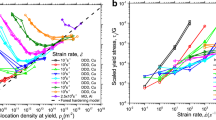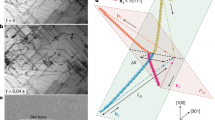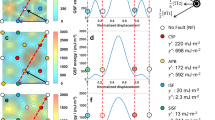Abstract
At the microscopic scale, the strength of a crystal derives from the motion, multiplication and interaction of distinctive line defects called dislocations. First proposed theoretically in 1934 (refs 1–3) to explain low magnitudes of crystal strength observed experimentally, the existence of dislocations was confirmed two decades later4,5. Much of the research in dislocation physics has since focused on dislocation interactions and their role in strain hardening, a common phenomenon in which continued deformation increases a crystal's strength. The existing theory relates strain hardening to pair-wise dislocation reactions in which two intersecting dislocations form junctions that tie the dislocations together6,7. Here we report that interactions among three dislocations result in the formation of unusual elements of dislocation network topology, termed ‘multi-junctions’. We first predict the existence of multi-junctions using dislocation dynamics and atomistic simulations and then confirm their existence by transmission electron microscopy experiments in single-crystal molybdenum. In large-scale dislocation dynamics simulations, multi-junctions present very strong, nearly indestructible, obstacles to dislocation motion and furnish new sources for dislocation multiplication, thereby playing an essential role in the evolution of dislocation microstructure and strength of deforming crystals8. Simulation analyses conclude that multi-junctions are responsible for the strong orientation dependence of strain hardening in body-centred cubic crystals.
This is a preview of subscription content, access via your institution
Access options
Subscribe to this journal
Receive 51 print issues and online access
$199.00 per year
only $3.90 per issue
Buy this article
- Purchase on Springer Link
- Instant access to full article PDF
Prices may be subject to local taxes which are calculated during checkout




Similar content being viewed by others
References
Orowan, E. Zur kristallplastizitat. Z. Phys. 89, 605–659 (1934)
Taylor, G. The mechanism of plastic deformation in crystal. Part I. Theoretical. Proc. R. Soc. A 145, 363–404 (1934)
Polanyi, M. Uber eine Art Gutterstorung, die einen kristall plastich machen konnte. Z. Phys. 89, 660–664 (1934)
Hirsch, P. B., Horne, R. W. & Whelan, M. J. Direct observations of the arrangement and motion of dislocations in aluminium. Phil. Mag. 1, 677–684 (1956)
Hirth, J. P. & Lothe, J. Theory of Dislocations 2nd edn, 9–13 (Wiley, New York, 1982)
Saada, G. Sur le durcissement dû à recombinaison des dislocations. Acta Metall. 8, 841–852 (1960)
Franciosi, P., Berveiller, M. & Zaoui, A. Latent hardening in copper and aluminium single crystals. Acta Metall. 28, 273–283 (1980)
Guiu, F. & Pratt, P. L. The effect of orientation on the yielding and flow of molybdenum single crystals. Phys. Status Solidi 15, 539–552 (1966)
Hirth, J. P. & Lothe, J. Theory of Dislocations 2nd edn, 269–270 (Wiley, New York, 1982)
Basinski, S. J. & Basinski, Z. S. in Dislocations in Solids Vol. 4 (ed. Nabarro, F. R. N.) 261–362, (North Holland, Amsterdam, 1979)
Nabarro, F. R. N., Basinski, Z. S. & Holt, D. B. The plasticity of pure single crystals. Adv. Phys. 50, 193–233 (1964)
Madec, S. R., Devincre, B. & Kubin, L. P. From dislocation junctions to forest hardening. Phys. Rev. Lett. 89, 255508 (2002)
Hähner, P. & Zaiser, M. Dislocation dynamics and work hardening of fractal dislocation cell structures. Mater. Sci. Eng. A 272, 443–454 (1999)
Abraham, F. F. et al. Simulating materials failure by using up to one billion atoms and the world's fastest computer: Work hardening. Proc. Natl. Acad. Sci. USA 99, 5783–5787 (2002)
Frank, F. C. & Read, W. T. Multiplication processes for slow moving dislocations. Phys. Rev. 79, 722–723 (1950)
Bulatov, V. V. et al. Scalable line dynamics in ParaDiS. Supercomputinghttp://www.sc-conference.org/sc2004/schedule/pdfs/pap206.pdf (2004).
Mughrabi, H. Dislocation wall and cell structures and long-range internal stresses in deformed metal crystals. Acta Metall. 31, 1367–1379 (1983)
Kubin, L. P. & Canova, G. R. The modelling of dislocation patterns. Scr. Metall. Mater. 27, 957–962 (1992)
Ghoniem, N. M., Huang, J. M. & Wang, Z. Q. Affine covariant-contravariant vector forms for the elastic field of parametric dislocations in isotropic crystals. Phil. Mag. Lett. 82, 55–63 (2002)
Finnis, M. W. & Sinclair, J. S. A simple empirical N-body potential for transition metals. Phil. Mag. A 50, 45–55 (1984)
Acknowledgements
This work was supported by the US DOE Office of Basic Energy Sciences and the NNSA ASC program. We thank E. Chandler and C. Mailhiot for their encouragement and unwavering support of the ParaDiS code development effort, D. Lassila for providing the purified molybdenum crystals, M. LeBlanc for performing the mechanical tests, R. Cook for graphic design and F. Abraham and G. Campbell for critical reading and editorial suggestions for the manuscript. This work was performed under the auspices of the US DOE by the Lawrence Livermore National Laboratory.
Author information
Authors and Affiliations
Corresponding author
Ethics declarations
Competing interests
Reprints and permissions information is available at npg.nature.com/reprintsandpermissions. The authors declare no competing financial interests.
Supplementary information
Supplementary Discussion 1
Relative strength of binary and ternary junctions. This discussion presents a detailed comparison of the relative strength of binary and ternary junctions computed in a large series of Dislocation Dynamics simulations. (PDF 1235 kb)
Supplementary Discussion 2
Why the hardening anisotropy can not be explained by the binary collisions alone? This discussion argues that enhanced hardening in 001 straining can not be attributed entirely to the binary dislocation collisions. (PDF 114 kb)
Supplementary Figure 1
Reproducibility of large scale DD simulations. This figure shows the results of a second series of large-scale DD simulations complementary to the simulations presented in figure 3 of the main text. The new series confirms a significantly enhanced hardening in 001 straining and no hardening in 011 and "doctored" 001 straining simulations. (PDF 98 kb)
Supplementary Figure 2
New experimental data on the hardening anisotropy. This figure presents results of new straining experiments on ultra-pure molybdenum single crystals confirming that the hardening anisotropy persists at elevated temperatures up to 500°K. (PDF 172 kb)
Supplementary Figure 3
The evolution of dislocation network topology. This figure shows how the topological composition of the dislocation networks changes with increasing strain. Under 001 straining, the multi-junctions become increasingly pervasive. (PDF 89 kb)
Supplementary Movie 1
Formation and unzipping of a binary junction. Two dislocation lines are brought to intersection at their mid-points at which point the elastic interaction is turned on. The dislocations merge into (zip) a junction line (red) that eventually unzips after stress is applied. (MOV 3445 kb)
Supplementary Movie 2
Formation of a (ternary) multi-junction. After two dislocations zip a binary junction, a third dislocation is brought to intersection with the binary junction at its mid-point. The interaction among the lines makes them zip a long ternary junction forming two 4-nodes at the end of the resulting multi-junction. (MOV 4030 kb)
Supplementary Movie 3
Unzipping of a ternary junction. Three dislocations are brought to intersection at their mid-points zipping a ternary junction. Under applied stress the multi-junction unzips allowing the dislocations to glide on. (MPG 1761 kb)
Supplementary Movie 4
Multi-junctions can act as regenerative sources of new dislocations. Rather than unzip, the multi-junction can also act a source of new dislocations. In this fragment, the junction line is shown to bow under stress eventually reaching instability. The resulting dislocation loop expands concentrically around the multi-junction while the latter returns to its initial configuration and is ready to emit another dislocation loop. (WMV 778 kb)
Supplementary Movie 5
Formation and growth of the multi-junction sub-network. This movie shows the evolution of a dislocation network in a DD simulation of single crystal molybdenum strained with the constant rate of 1/s. Initially scarce, the dislocations quickly multiply forming a dense network. Early on, the network is all green meaning that it is made of regular binary junctions. Soon, first few multi-junctions form (white), initiating the formation of increasingly dense sub-network of interconnected multi-junctions. Similar to the growth of a coral reef, the multi-junction sub-network is seen to grow by attachment of new multi-junctions to the existing ones. The white sub-network is mostly static and forms a strong skeleton of the entire network structure. At the same time, the overall plasticity is carried on by the green lines that remain unincorporated in the multi-junction sub-network. (MOV 14594 kb)
Rights and permissions
About this article
Cite this article
Bulatov, V., Hsiung, L., Tang, M. et al. Dislocation multi-junctions and strain hardening. Nature 440, 1174–1178 (2006). https://doi.org/10.1038/nature04658
Received:
Accepted:
Issue Date:
DOI: https://doi.org/10.1038/nature04658
This article is cited by
-
Pb induced dislocation defects of PtCo systems: Strain-triggered oxygen reduction reaction for PEMFC
Nano Research (2024)
-
Nanoscale ductile fracture and associated atomistic mechanisms in a body-centered cubic refractory metal
Nature Communications (2023)
-
Incorporating Dislocation Mechanisms into a Phenomenological Cyclic Plasticity Model for Structural Alloys
Metallurgical and Materials Transactions A (2023)
-
Hetero-Boundary-Affected Regions in Heterostructured Materials
JOM (2023)
-
Simultaneous bright- and dark-field X-ray microscopy at X-ray free electron lasers
Scientific Reports (2023)
Comments
By submitting a comment you agree to abide by our Terms and Community Guidelines. If you find something abusive or that does not comply with our terms or guidelines please flag it as inappropriate.



